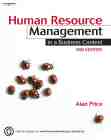Human Resource Planning
 Human resource planning
Human resource planning
A process which anticipates
and maps out the consequences of business strategy on an organization's
human resources. This is reflected in planning of skill and competence
needs as well as total headcounts.
For resourcing strategies to be implemented they must be translated
into practical action. The strategic process can be organized logically - for example,
following the decision sequence shown on page 351 of Human Resource Management in a
Business Context. For these decisions to be taken, information must be obtained,
consequences gauged, political soundings taken and preferences assessed.
It is clear that many of these decisions are fundamental to an organization.
If the implications are major, strategic decisions are taken at the centre of the business.
The role of the human resource function is two-fold:
1. To participate in the decision process by providing information
and opinion on each option, including:
* redundancy or recruitment costs
* consequences on morale
* redeployment/outplacement opportunities
* availability of skilled staff within the organization
* availability of suitable people in the job market
* time constraints
* development/training needs/schedules
* management requirements.
This forms part of the information collated from the organization as a whole
2. To support line managers dealing with the people consequences of implementing
the decision. Information already gathered provides the basis for a human resource plan. (
Continued on page 351 of Human Resource Management in a Business Context).
 People as numbers
People as numbers
The manpower planning approach which addresses questions such as:
* How many staff do we have/need?
* How are they distributed?
* What is the age profile?
* How many will leave in each of the next five years?
* How many will be required in one, five, ten years?
Human Resource Information
Systems are invaluable in answering these questions.
 Forecasting methods
Forecasting methods
Human resource planners have a choice of techniques open to them, including:
extrapolation (of past trends); projected production/sales; employee analysis;
scenario building.
Explained further in pages 355-356 of Human
Resource Management in a Business Context.
 Employee turnover
Employee turnover
Turnover
covers the whole input-output process from recruitment to dismissal or
retirement and takes the consequences of promotion and transfer into account.
(See page 359 of Human
Resource Management in a Business Context.
 'Soft' planning
'Soft' planning
HRM
implies that planning has to go beyond the 'numbers game' into the softer
areas of employee attitudes, behaviour and commitment. These aspects are
critical to HR development, performance assessment and the management of
change.
(See pages 360-361 of Human
Resource Management in a Business Context.


|




